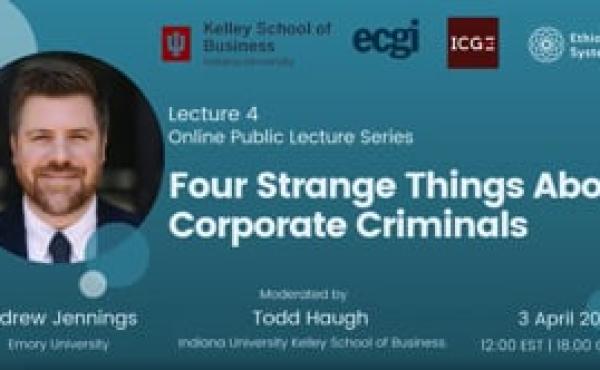
The ECGI blog is kindly supported by

Corporate Crime and Capitalism
A Commentary on Andrew Jennings’ Kelley-ECGI Lecture ‘Four Strange Things About Corporate Criminals’
What happens when a system built to punish individual wrongdoers is applied to collective legal fictions? In his recent lecture for the Kelley–ECGI Speaker Series, Professor Andrew Jennings of Emory University examined the strange and sometimes surreal results of applying criminal law to corporations. Drawing on a series of recent papers, Jennings outlined four structural distortions that appear when criminal and corporate law intersect—none of which fit comfortably within our usual ideas about responsibility, deterrence, or justice.
His talk invited the audience to look closely at four specific phenomena: the sale of criminal liability, the scapegoating of subsidiaries, the problem of self-incrimination through recordkeeping, and the nearly complete impunity of financial backers. What emerged was not a picture of broken enforcement, but one of legal systems functioning exactly as designed—just not in harmony.
Crime for Sale
The first distortion Jennings presented is that corporate criminals can effectively sell their crimes. While criminal liability is inseparable from the person in traditional law, the corporate version can transfer through mergers and acquisitions. Jennings described how, under the doctrine of respondeat superior, a company is liable for the criminal acts of its employees so long as those acts occurred within the scope of employment and with some intent—however slight—to benefit the company. If that liability exists, it travels with the business when ownership changes.
The Bankrate case provided a clear example. The company’s CFO committed accounting fraud, resulting in both SEC and DOJ investigations. Before those investigations concluded, the company was acquired by Red Ventures. The buyer was aware of the ongoing issues and later entered into a settlement agreement with the DOJ acknowledging responsibility for misconduct that predated the acquisition. As Jennings explained, this is a relatively unremarkable event in the corporate context. Through a combination of successor liability and vicarious liability, the criminal risk attached to Bankrate became a condition of sale. Jennings described this as a functioning market for corporate criminals—one that includes buyers of unknown offenders, known offenders, and companies already under settlement. These transactions present an opportunity. Prosecutors concerned with collateral consequences—especially bankrupting a firm or triggering mass layoffs—can use M&A as a moment to impose full penalties.
Scapegoating Subsidiaries
The second strange feature of corporate criminal enforcement is the ability of companies to assign blame to less critical parts of their structure. Jennings explored how large firms sometimes manage criminal liability by directing prosecutors toward subsidiaries, rather than taking responsibility at the parent level. This strategy was apparent in the Goldman Sachs case linked to the 1MDB embezzlement. The firm, through several executives and units, facilitated part of the scheme. But when the DOJ brought charges, only Goldman Sachs Malaysia—one of its smaller subsidiaries—entered a guilty plea.
This arrangement, Jennings argued, is not accidental. Corporate groups routinely engage in asset partitioning to allocate risk. But while that practice is common in tort and contract law, it functions differently in the criminal context. Jennings described this as a form of scapegoating that requires the consent of both parties. Prosecutors may agree to convict a subsidiary in order to obtain formal accountability while avoiding the economic and reputational consequences of convicting a parent company—particularly in regulated industries. The system of plea bargaining, combined with the broad reach of respondeat superior, enables prosecutors to choose which part of a corporate group will bear the criminal mark.
Paper Trail to Prison
The third distortion concerns the evidentiary trail left behind by corporate criminals. Unlike individual offenders, who might avoid creating documentation that could be used against them, corporations often generate the very evidence that leads to their prosecution. Jennings called this problem “criminal recordkeeping.” He explained that the complexity and longevity of corporate activity requires internal documentation—whether it’s to track business decisions, comply with regulations, or monitor performance. But in the case of misconduct, those same records—emails, memos, spreadsheets—serve as incriminating material.
He offered a framework for thinking about how recordkeeping plays out across different types of organizations. In illicit organizations engaging in illicit activity—such as drug trafficking rings—record creation is dangerous and typically avoided. In licit organizations engaged in illicit conduct—such as bribing public officials—the need to hide the misconduct conflicts with internal systems that demand justification for expenditures. And in licit organizations performing licit activities illicitly—such as accounting fraud—recordkeeping is built into the system. Even the wrongdoing is documented. Jennings noted that this puts corporate criminals in a uniquely vulnerable position. Internal controls, compliance systems, and retention policies ensure that documents survive—and make it harder for misconduct to go undetected.
The Investor Loophole
The final observation in Jennings’ lecture focused on the role of investors. While shareholders benefit financially from a corporation’s success—including profits generated by illegal conduct—they are almost never prosecuted. Jennings framed this with a provocative comparison. If someone offers you a chance to fund an Adderall distribution scheme for $50,000, you’d likely expect legal consequences. But if that same scheme is embedded in a telemedicine startup and financed through millions in venture capital, the risk of prosecution disappears.
He explained that this disparity has nothing to do with legal doctrine. Corporate law provides limited liability to shield shareholders from company debts, but not from criminal liability for their own conduct. Instead, Jennings argued, the absence of investor prosecutions stems from a prosecutorial belief in shareholder innocence. DOJ materials regularly refer to shareholders as “blameless,” and companies sometimes disclose the theoretical risk of investor liability in filings—but no cases follow. The result is a system in which capital flows freely to risky ventures with little concern for legal exposure. Investors, even when knowingly funding wrongdoing, remain untouched.
A System of Split Logic
Taken together, these four observations point to a structural mismatch. Corporate law is built for organizing capital and allocating risk. Criminal law has many of its own functions, not related to capital formation. When the two intersect, enforcement becomes less about conviction and more about negotiation, structure, and narrative. Jennings ended his lecture by asking a fundamental question: Does this mean we need to totally revitalize corporate criminal law to make it truer to either corporate or criminal law—or does it point us toward the core question: given that corporations can’t see, think, or act except through humans, why punish the chair that trips you?
_______________
This lecture is part of the Indiana University - ECGI Online Series, a public lecture series on corporate governance. The Kelley School of Business Institute for Corporate Governance (ICG+E), in partnership with Ethical Systems, collaborates with ECGI to deliver this ongoing initiative. As part of this public lecture series, distinguished speakers share insights on the evolving landscape of governance, finance, and market regulation.







